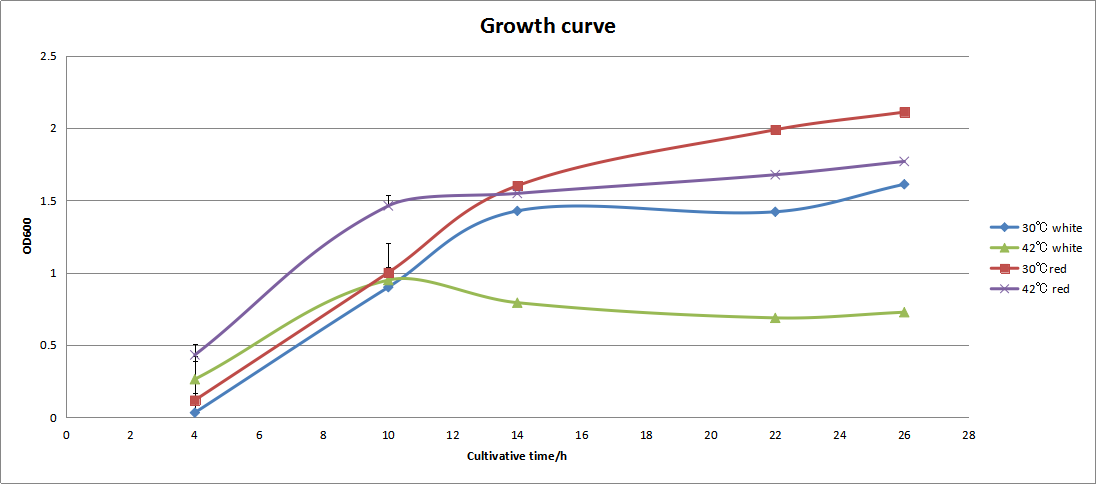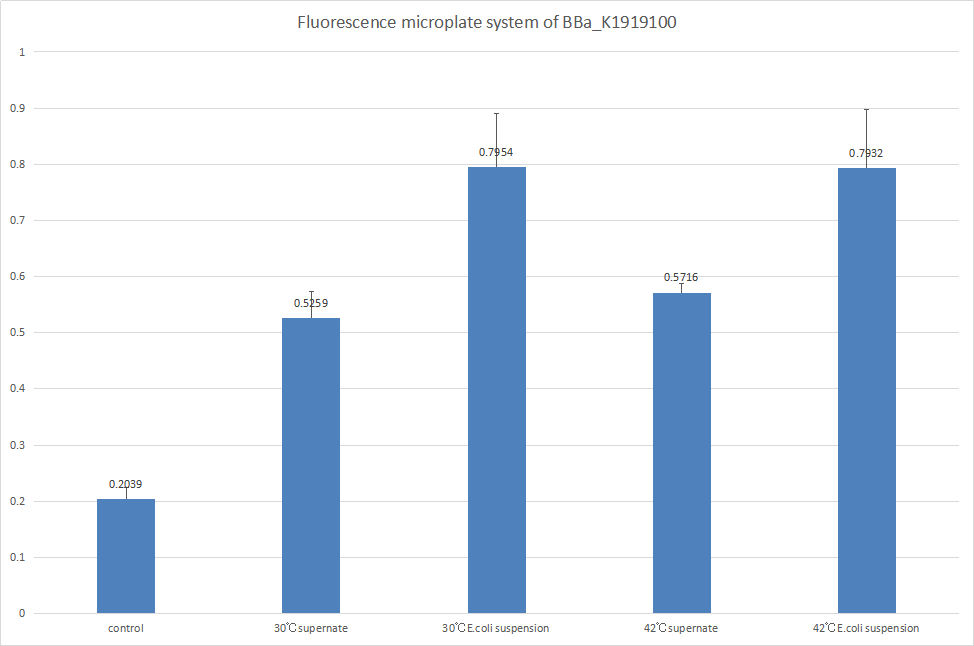Part:BBa_K1919100
Usage and Biology
This device is a combination of two parts submitted by previous igem teams that one (BBa_K608351) is a temperature-regulated promoter followed by the other (BBa_K1497008 )that a gene coding for a protein hokD which induces cell lysis. The promoter we chose won’t start translation until the temperature is raised to 37℃. And at 42℃ can we get the peck efficiency of expression. The promoter is in fact a composite sequence that preceding the regulated promoter is the control sequence which can synthesis λ cI repressor. λ cI repressor binds with the promoter sequence when environment temperature is 28~30℃ while at 42℃, the protein denatures and falls off by which initiate the transcription. We use the temperature-regulated promoter to express hokD gene. The hokD gene of E. coli transcribes for a small polypeptide that causes cell death by elimination of vital cell wall functions. In short , our device can induce cell lysis when temperature is raised to 42℃.
To deliver the antimicrobial peptides in the right place and at the right time, we designed and constructed this temperature-regulated device. When put under the sole of feet, our peptide-expressing E.coli cells in the insole would be incubated at a warmer environment due to body temperature. We use this promoter to control the synthesis of hokD for the raised temperature will promote the translation of hokD which following the promoter.
Sequence and Features
- 10COMPATIBLE WITH RFC[10]
- 12INCOMPATIBLE WITH RFC[12]Illegal NheI site found at 7
Illegal NheI site found at 30
Illegal NotI site found at 781 - 21COMPATIBLE WITH RFC[21]
- 23COMPATIBLE WITH RFC[23]
- 25COMPATIBLE WITH RFC[25]
- 1000COMPATIBLE WITH RFC[1000]
Characterization
Quantitative measurement:
1)OD600 measurement:
figure1
table1
table2
table3
table4
OD600:We build two kinds of plasmids to test the expression of temperature-sensitive device(BBa_K1919100-team and BBa_K1919100 with reporter E0450-RFP team).Comparing the same E.coli strain, . Despite of the temperature factor, the OD 600 of 30℃team and 42℃team all rose before 10 hours. Then 30℃team remained the same trend until 14 hours and have a platform for 8 hours then rose again to OD600 1.6. But the 42℃team’s OD 600 showed a significant decline after that rise phase during 10 to 14 hours and then grown steadily.The OD 600 of 30℃team-RFP and42℃team-RFP also rose before 10 hours together. Then the The OD 600 of 30℃team-RFP held this trend and rose until 14 hours then it still rose in a more gentle way. But the OD 600 of 42℃team-RFP showed a steady trend after 10 hours and grew slightly.
2)Fluorescence microplate system:
figure2
The results shows this device can work in 42℃, but it doesn’t work high-efficiently. Combined with OD600 measurement, we found two results for its low efficuent.Firstly, the expression of RFP protein is lower than normal strain, which only has reporter part in the plasmid. Secondly, the RFP protein has a similar emission wave when test OD600, and that may be the most biology nosie in this measurement. What’s more, we changed eGFP reporter to test this part, but it didn’t finish.
Reference
composite promoter BBa_K608351 Designed by Theodhor Tiko Group:iGEM11_Freiburg (2011-09-14)
hokD BBa_K1497008 Designed by Sascha Hein, Daniel Sachs, Christian Sator Group: iGEM14_TU_Darmstadt (2014-10-07)
//biosafety/kill_switch
//cds/membrane/lysis
| device_type | lysis |
| family | λ reperssor |






